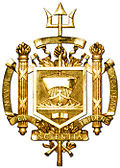| Commodore Uriah P. Levy Center and Jewish Chapel | |
|---|---|
 The chapel exterior in 2010 | |
| Religion | |
| Affiliation | Judaism |
| Ecclesiastical or organizational status | Synagogue |
| Status | Active |
| Location | |
| Location | Annapolis, Maryland |
| Country | United States |
Location within Maryland | |
| Geographic coordinates | 38°58′49″N76°28′52″W / 38.980278°N 76.481189°W |
| Architecture | |
| Architect(s) | Joseph Boggs |
| General contractor | The Whiting-Turner Contracting Company |
| Groundbreaking | November 2, 2003 |
| Completed | 2005 |
| Construction cost | $8 million |
| Specifications | |
| Interior area | 35,000 square feet (3,300 m2) |
| Materials | Jerusalem stone |
| Website | |
| usna | |
| [1] [2] | |
Commodore Uriah P. Levy Center and Jewish Chapel is the Jewish chapel at the United States Naval Academy, in Annapolis, Maryland.
Contents
The center is named in honor of Commodore Uriah P. Levy (1792–-1862), the first Jewish commodore in the United States Navy, who is famous for refusing to flog his sailors. [3] [2] The Levy Center is adjacent to Mitscher Hall and contains a 410-seat synagogue, a fellowship hall, a Character Learning Center, classrooms, and offices for the Brigade's social director, the academic board, and the academy's Honor Board. [2]
Before the chapel was completed in 2005, Jewish midshipmen attended Congregation Knesset Israel in downtown Annapolis, [4] or held services in the interfaith chapel at Mitscher Hall.


